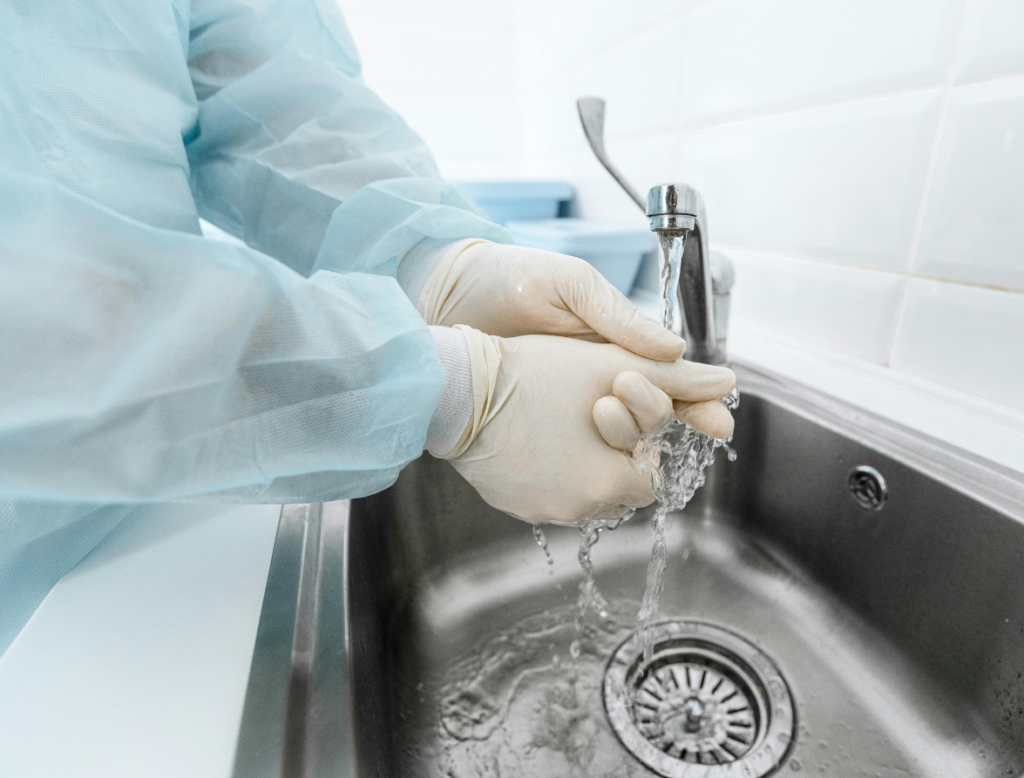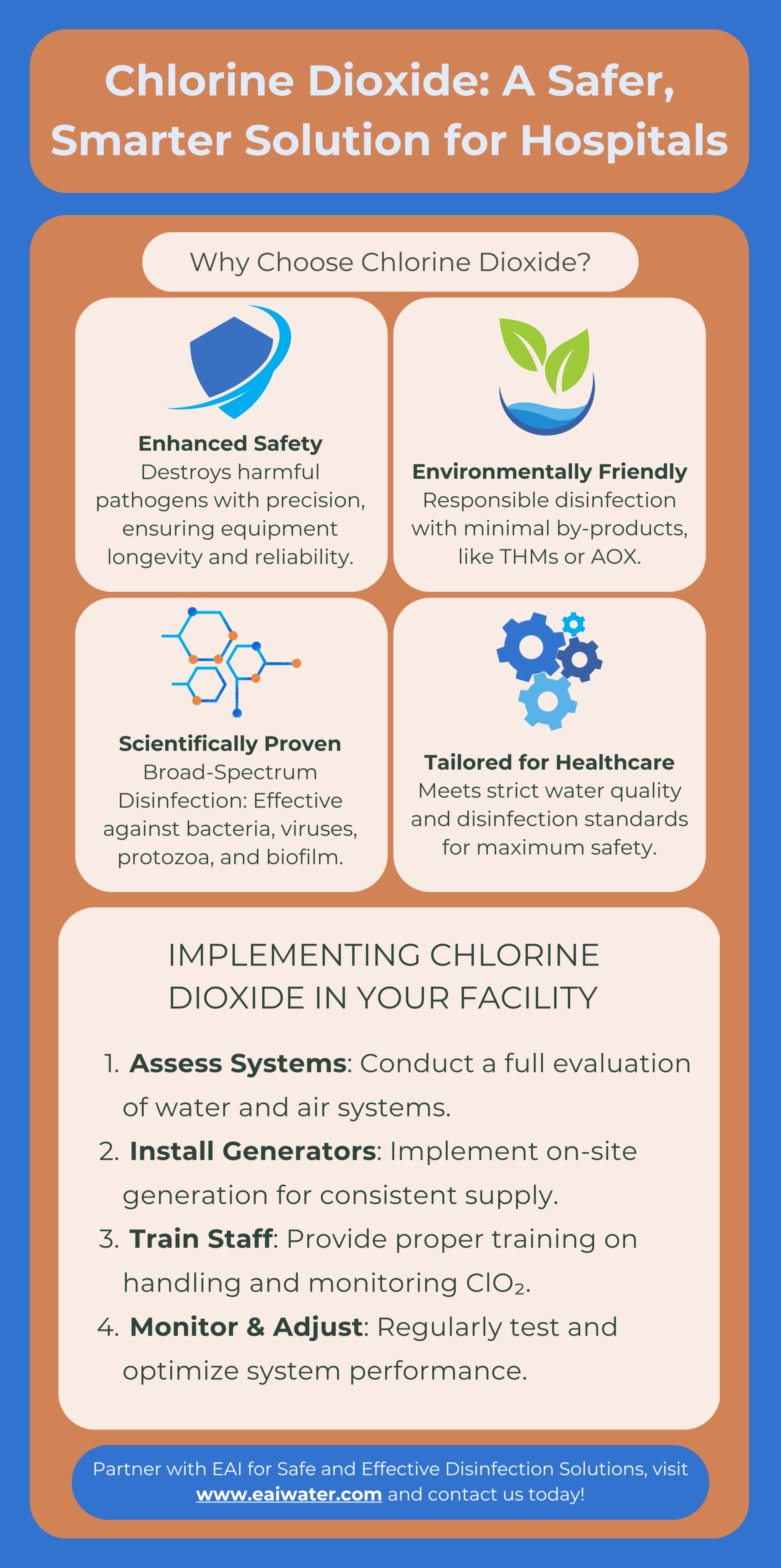Chlorine Dioxide in Hospitals: Best Practices for Infection Control
At EAI, we are committed to delivering advanced disinfection technologies to safeguard public health in healthcare environments. Our tailored chlorine dioxide solutions offer hospitals an unparalleled approach to infection control by combining superior efficacy with eco-friendly practices. With our Total Water approach, we ensure comprehensive water and air disinfection strategies that protect both patients and staff.

The Role of Chlorine Dioxide in Infection Control
Chlorine dioxide (ClO₂) has emerged as a leading disinfectant in healthcare settings due to its unique properties:
- Broad-spectrum efficacy: Kills bacteria, viruses, and fungi, including Legionella and MRSA.
- Eco-friendly: Produces minimal harmful by-products, such as trihalomethanes (THMs).
- Residual disinfection: Provides long-lasting protection in water systems.
By integrating chlorine dioxide into infection control protocols, hospitals can meet stringent health and safety standards while mitigating risks associated with traditional disinfection methods.
Why Chlorine Dioxide is the Gold Standard for Medical Sterilization

Healthcare facilities demand disinfection methods that not only ensure pathogen elimination but also prioritize equipment longevity, patient safety, and regulatory compliance. Chlorine dioxide (ClO₂) rises to the occasion by offering:
1. Comprehensive Disinfection
Chlorine dioxide’s broad-spectrum biocidal properties make it effective against bacteria, viruses, protozoa, and biofilms. Unlike traditional disinfectants, it works across air, water, and surfaces, making it an all-in-one solution for hospitals. For example:
- Air Disinfection: Eliminates airborne pathogens in operating rooms and ICUs.
- Water Systems: Prevents Legionella in plumbing systems.
- Surfaces: Removes biofilm from medical equipment and high-touch areas.
2. Biofilm Prevention
Biofilm formation in hospital water systems and medical devices can harbor harmful microorganisms. Chlorine dioxide disrupts biofilms at the molecular level, ensuring consistent sanitation and preventing contamination.
3. pH Independence
Unlike traditional chlorine, chlorine dioxide remains effective across a wide pH range (5-9), ensuring reliable disinfection regardless of water chemistry variations.
4. Compliance-Ready Disinfection
Hospitals are required to meet stringent guidelines from agencies like the CDC and EPA. Chlorine dioxide’s effectiveness aligns with these regulatory requirements, helping healthcare facilities maintain compliance and avoid penalties.
Regulatory Compliance for Healthcare Facilities
Ensuring compliance with regulatory standards is critical for hospital safety:
- CDC Guidelines: Chlorine dioxide aligns with CDC recommendations for preventing waterborne infections in healthcare facilities, particularly those involving Legionella outbreaks.
- EPA Standards: Adheres to EPA guidelines for drinking water disinfection and minimizing by-products.
- ASHRAE Standards: Supports ASHRAE Standard 188 for managing Legionella risks in building water systems.
Hospitals operating in New York and New Jersey must also meet specific local requirements, such as NYC’s Local Law 77 and New Jersey’s NJAC 8:26. Incorporating EAI’s solutions simplifies compliance through robust monitoring, testing, and documentation.
Best Practices for Implementing Chlorine Dioxide in Hospitals
To maximize the effectiveness of chlorine dioxide in infection control, hospitals must adopt comprehensive best practices tailored to their specific needs. Below are actionable steps for integrating chlorine dioxide into healthcare water and air systems:
1. Routine Water System Testing
- Frequency: Perform testing at least monthly, or more frequently in high-risk areas such as intensive care units.
- Parameters: Monitor chlorine dioxide levels, pH, and temperature to ensure optimal disinfection.
- Tools: Use specialized testing kits or automated monitoring systems for accurate results.
2. Targeted Disinfection of High-Risk Areas
- Deploy chlorine dioxide for sterilizing water used in humidifiers, dialysis equipment, and surgical instruments.
- Ensure all cooling towers and HVAC systems are treated to prevent biofilm formation and minimize airborne pathogen risks.
3. Systematic Training for Staff
- Train facility managers and operators on the correct handling and dosing of chlorine dioxide.
- Include guidelines for emergency responses, such as dealing with chemical spills or unexpected system contamination.
4. Long-Term Maintenance and Monitoring
- Schedule regular inspections of disinfection systems to identify any signs of scaling or corrosion.
- Collaborate with EAI’s team for routine audits and performance evaluations to maintain peak efficiency.
Real-World Applications: How Chlorine Dioxide Saves Lives
Hospitals and healthcare facilities that implement chlorine dioxide protocols for disinfection often experience notable improvements in maintaining sterile environments and reducing the prevalence of waterborne pathogens. Chlorine dioxide’s ability to penetrate biofilms and ensure consistent disinfection across various surfaces makes it particularly effective for infection control. Its use aligns with the rigorous standards required in healthcare settings, providing a reliable method to safeguard both patients and staff.
Why Choose EAI for Healthcare Disinfection Solutions?
EAI’s chlorine dioxide generators are designed for healthcare-specific challenges. By leveraging single-chemical precursors, our systems ensure high-purity chlorine dioxide tailored to the stringent demands of hospitals. Key benefits include:
- Compact Design: Easy integration into existing infrastructure.
- Eco-Friendly Operation: Minimal environmental impact with reduced by-products.
- Comprehensive Support: From system design to ongoing maintenance, EAI delivers unmatched expertise.
Learn more about our chlorine dioxide solutions.
Enhanced Safety with Chlorine Dioxide Systems
Minimized By-Products for Safer Environments
Traditional disinfectants, like chlorine, produce harmful by-products such as trihalomethanes (THMs) and chlorates, which can pose risks to patients and healthcare staff. Chlorine dioxide eliminates these concerns by producing very low levels of by-products while ensuring powerful disinfection.
Non-Corrosive Properties
Unlike certain sterilants, chlorine dioxide is less corrosive to medical equipment and facility infrastructure, reducing maintenance costs while ensuring longevity. Hospitals can depend on its effectiveness without compromising on safety.
Environmentally Responsible Choice
EAI’s chlorine dioxide solutions are designed to meet sustainability goals by minimizing chemical waste and aligning with green healthcare initiatives. Chlorine dioxide’s low environmental footprint makes it a preferred choice for eco-conscious healthcare providers.
Addressing Hospital-Specific Challenges
Combatting Legionella in Water Systems
Waterborne pathogens like Legionella thrive in hospital plumbing, leading to significant health risks. Chlorine dioxide systems prevent Legionella colonization by targeting biofilms, ensuring water quality meets the highest standards.
Disinfecting High-Traffic Areas
Hospitals often have high-risk zones with elevated infection potential, such as surgical units and ICUs. Chlorine dioxide ensures thorough disinfection of surfaces, equipment, and air in these areas, creating safer environments for patients and staff.
Tailored Solutions for Healthcare Facilities
EAI provides site-specific chlorine dioxide generation systems, ensuring hospitals achieve effective disinfection across all areas. From thermal storage tanks to secondary water disinfection, our solutions are engineered to address the unique needs of healthcare facilities.
Take Action with EAI
EAI Water is committed to helping hospitals enhance infection control through innovative chlorine dioxide solutions. From customized generators to ongoing technical support, we provide end-to-end solutions tailored to healthcare needs. Partner with us to safeguard patient health and ensure regulatory compliance. Contact us today to learn more about how we can transform your facility’s disinfection systems.
FAQs
Q: Is chlorine dioxide used in hospitals?
A: Yes, chlorine dioxide is widely used in hospitals for its superior disinfection capabilities. It is applied to disinfect water systems, air, and surfaces, effectively controlling pathogens while meeting stringent regulatory requirements.
Q: What is chlorine used for in hospitals?
A: Chlorine is traditionally used for water disinfection in hospitals. However, chlorine dioxide is increasingly preferred due to its broader biocidal spectrum, lower by-products, and ability to prevent biofilms.
Q: What is chlorine dioxide disinfectant used for?
A: Chlorine dioxide is used for water disinfection, surface sanitation, air purification, and sterilization of medical equipment. Its versatility makes it a comprehensive solution for infection control in healthcare settings.
Q: What is a disadvantage for using chlorine dioxide for disinfection?
A: One limitation is that chlorine dioxide must be generated on-site due to its instability during storage. However, EAI’s advanced chlorine dioxide generators ensure reliable on-site production, eliminating this challenge.